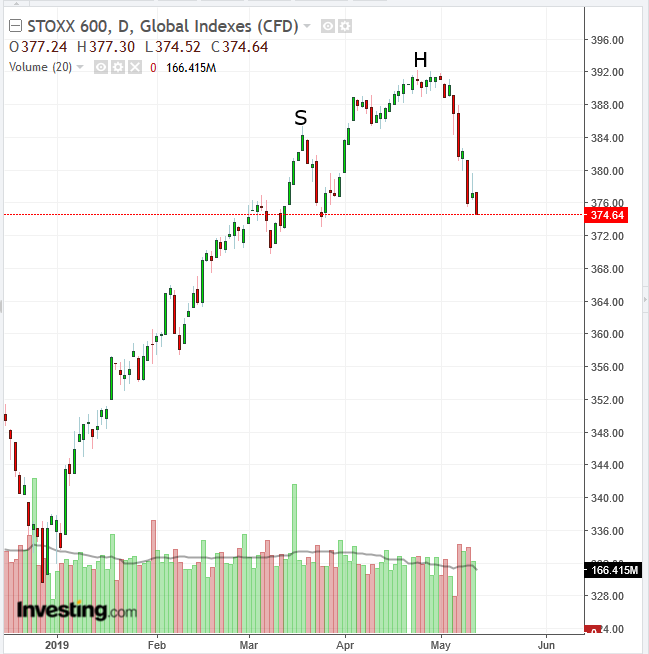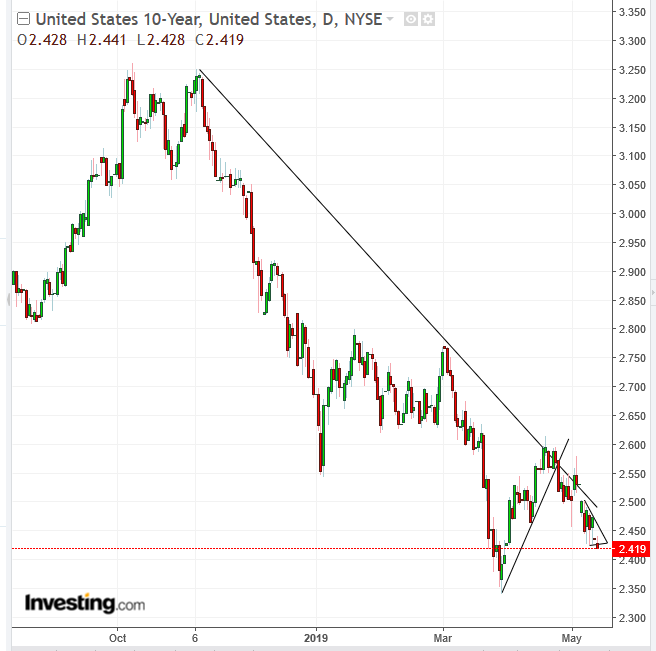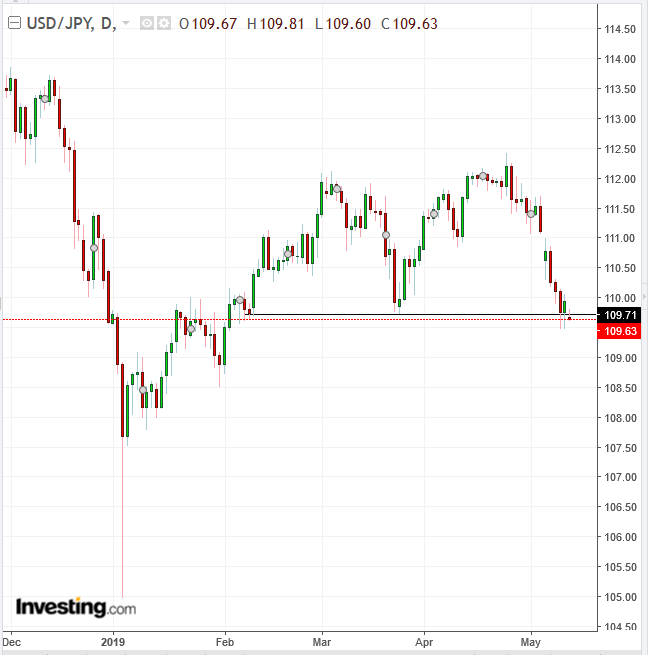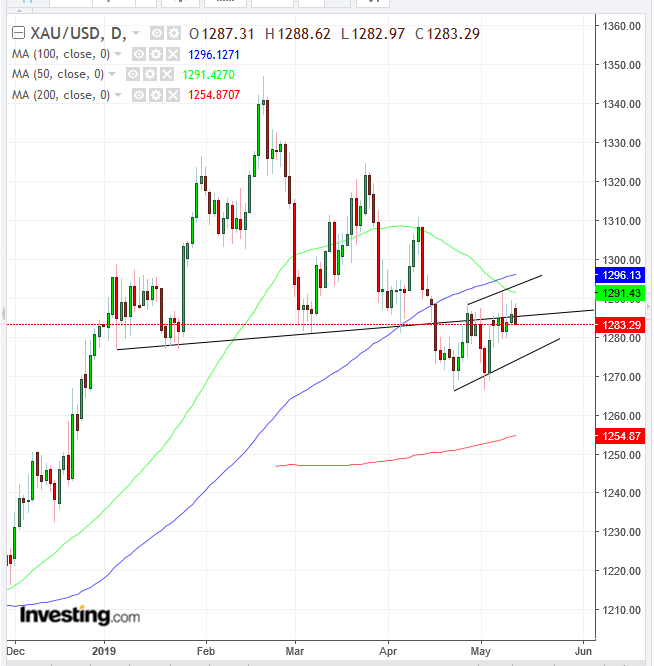- U.S. futures dive deeper into the red as investors dread Chinese tariff retaliation
- European shares suffer highest selling volumes since Oct. 10
- Yen, Treasury climb on risk off
- Earnings this week include Vodafone (NASDAQ:VOD), Tencent (HK:0700), Cisco (NASDAQ:CSCO), NVIDIA (NASDAQ:NVDA) and Alibaba (NYSE:BABA). There's a lot at stake for the Chinese e-commerce giant if heightened U.S.-China trade tensions lead to severe weakening of consumer demand.
- A slew of Federal Reserve policymakers will speak this week: Boston Fed President Eric Rosengren and Fed Vice Chairman Richard Clarida speak at a “Fed Listens” event hosted by the Boston Fed. New York Fed President John Williams) speaks at an event in Zurich. Kansas City Fed President Esther George and Richmond Fed President Thomas Barkin also make appearances.
- Japan balance of payments is due on Tuesday.
- China industrial production and retail sales are out on Wednesday.
- U.S. retail sales and industrial production also also scheduled for Wednesday.
- Bank of Indonesia holds an interest rate meeting on Thursday.
- Australian unemployment is out on Thursday.
- The MSCI Asia Pacific Index fell 0.7%.
- The MSCI Emerging Market Index dropped 0.6%.
- The Dollar Index was flat, giving up a small gain.
- The offshore yuan fell 0.8% to 6.8985 per dollar and the biggest drop in more than nine months.
- The euro climbed less than 0.05% to $1.1234, the strongest in three weeks.
- The yield on 10-year Treasurys dropped four basis points to 2.43%.
- Germany’s 10-year yield fell one basis point to -0.05%.
- The Bloomberg Commodity Index slid 0.3% to 78.46.
- LME nickel fell 0.8% to $11,830 per metric ton.
- West Texas Intermediate crude rose 0.3% to $61.86 a barrel. OPEC's monthly report, due on Wednesday, may strengthen the case for the group of oil producers to continue with production cuts.
- Soybeans slipped 0.9% to $8.02 a bushel.
Key Events
Futures on the S&P 500, Dow and NASDAQ 100 stood firmly in red territory this morning and European shares dropped as the U.S.-China trade war showed no signs of slowing down.

All charts powered by TradingView
The STOXX 600 slipped to the lowest price since March 25—and another 0.6% decline would push it to the the lowest level since March 12—as investors waited for details on China's retaliatory measures after the U.S. pressed ahead with higher tariffs on imports from the Asian country on Friday. Stocks on the pan-European benchmark sold off on the highest selling volume since October 10—a month and a half before the infamous global December rout. Technically, the index is in the making of a H&S top, with the left shoulder formed with the head’s low finding support by the lows of the left shoulder.
Germany’s DAX in particular underperformed as the high dependence of its listed companies on exports means they would be harshly hit by any further expansion of trade tariffs from the U.S.
In the earlier Asian session, the yuan extended a selloff while the yen and Treasurys advanced as investors ramped up their risk-off positions. Perhaps, the most unnerving aspect of the renewed trade headwind, for traders, is the lack of a set date on when high-level negotiations between the two economic powers will resume. An open-ended risk comes as kryptonite for the market, as it carries the highest uncertainty.
Japan’s Nikkei (-0.79%) suffered the highest-volume tumble, amid a selloff since March 8. China's Shanghai Composite (-1.21%), conversely, slid on contracting volumes—which somehow brightens the picture, as low participation may suggest the equity slide won’t last. South Korea's KOSPI (-1.38%) extended a double top but the preceding rally hovered close to October 2018-January 2019 bottom, which was the lowest since November 2016, before the so-called Trump-trade skyrocketed stocks. Hong Kong’s Hang Seng was closed in observance of the Birthday of the Budhha.
Global Financial Affairs
On Friday, U.S. shares bounced back from what would have been a fifth day of declines. Although the rebound was insufficient to recoup the sharp losses of the previous few days, it did save the week from the dubious honor of being the worst since December's rout. And it was mainly defensive sectors that managed to seal some gains, demonstrating investor uneasiness. Investors also increased safe-haven holdings such as the yen, Treasurys and gold—though the precious metal’s added demand was more likely a result of the weakening dollar.

The yield on 10-year Treasurys provided a downside breakout on an intraday basis, to a bearish pennant, resuming the medium-term downtrend line since the November top, after falling below the short-term uptrend line since March 28.

The yen strengthened against the dollar, with the USD/JPY pair completing a double top on an intraday basis.

Gold fell even amid widespread risk off, as it became more expensive after the USD rise. The precious metal is struggling against the neckline of a H&S top amid a return move. Its current trading pattern is creating a rising, bearish flag.
Overall, we argued that focusing on the ongoing trade headwind alone for a longer-term coherent market strategy may not be the wisest option. Mixed signals on the future of trade talks continued on Monday as White House top economic adviser Larry Kudlow said there is a “strong possibility” that Trump will meet Chinese President Xi Jinping at a G20 summit in Japan in late-June. On Sunday, he had acknowledged U.S. companies and consumers stand to take a hit from the higher tariffs imposed by the White House on Friday.
Meanwhile, Bitcoin held onto gains above $7,000 after soaring as high as $7,448 on Saturday. Is the digital currency finally acting like the safe haven its enthusiasts have long claimed it to be?
Up Ahead
Market Moves
Stocks
Currencies
Bonds
Commodities
